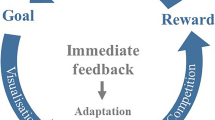Abstract
Instructional developers and others creating apps must choose from a wide variety of app development tools and technologies. Some app development tools have incorporated visual programming features, which enable some drag and drop coding and contextual programming. While those features help novices begin programming with greater ease, questions arise about the overall utility of visual tools for app development. Analyses and comparisons of app development tools and technologies would make their advantages and disadvantages apparent, enabling instructional technologists to make informed decisions about tool selection. Toward that end, this work generated a new fram ework for comparing app development tools. The criteria that comprise the framework were then used to compare multiple authoring tools and technologies for creating apps. Three app development tools, namely Corona, LiveCode and MoSync, emerged as particularly noteworthy for their utility and flexibility, and because they are free of monetary cost or have a free version.
Similar content being viewed by others
References
Abelson, H., Turbak, L. Morelli, R., Martin, F., & Wolber, D. (2012). NSF awards grant for App Inventor Teaching Project. Retrieved January 11, 2014, from http://appinventor.mit.edu/explore/news/nsf-awards-grant-app-inventor-teaching-project.html
ABI Research (2014). Android will account for 58% of smartphone app downloads in 2013, with iOS commanding a market share of 75% in tablet apps. Retrieved May 12, 2014, from https://www.abiresearch.com/press/android-will-account-for-58-of-smartphone-app-down
Adobe (2013). Adobe captivate app packager. Retrieved January 11, 2014, from http://helpx.adobe.com/captivate/using/captivate-app-packager.html
Demaine, E. D., Demaine, M. L., & Verrill, H. A. (2002). Coin-moving puzzles. More games of no chance, 42, 405–431.
Grover, S. & Pea, R. (2013). Computational thinking in K-12: A review of the state of the field. Educational Researcher, 42 (1), 38–43.
Holden, C. (2014). The local games lab ABQ: Homegrown augmented reality. TechTrends, 58 (1), 42–48.
Hsu, Y -C., & Ching, Y. -H. (2013). Mobile app design for teaching and learning: Educators’ experiences in an online graduate course. The International Review of Research in Open and Distance Learning, 14(4), 117–139.
Luterbach, K. J. (2013a). Building software development capacity to advance the state of educational technology. Educational Technology, 53 (2), 21–27.
Luterbach, K. J. (2013b). Elegant Instruction. Journal of Educational Technology Systems. 41 (2), 183–204.
Manovich, L. (2013). Software takes command. New York, NY: Bloomsbury Academic.
Martin, F., Pastore, R., & Snider, J. (2012). Developing mobile based instruction. TechTrends, 56 (5), 46–51.
Martin, J., Dikkers, S., Squire, K., & Gagnon, D. (2014). Participatory scaling through augmented reality learning through local games. TechTrends, 58 (1), 35–41.
Prensky, M. (2008). Programming is the new literacy. Edutopia. Retrieved January 11, 2014, from http://www.edutopia.org/programming
Resnick, M. (2012). Reviving Papert’s dream. Educational Technology, 52 (4), 42–46.
Rogers, E. (2003). Diffusion of innovations (5th edition). New York, NY: Free Press.
Wellesley College (2013). The hour of code. Retrieved January 11, 2014, from https://www.youtube.com/watch?v=FC5FbmsH4fw and http://www.wellesley.edu/news/2013/12/node/40715
Author information
Authors and Affiliations
Corresponding author
Rights and permissions
About this article
Cite this article
Luterbach, K.J., Hubbell, K.R. Capitalizing on App Development Tools and Technologies. TECHTRENDS TECH TRENDS 59, 62–70 (2015). https://doi.org/10.1007/s11528-015-0872-8
Published:
Issue Date:
DOI: https://doi.org/10.1007/s11528-015-0872-8




